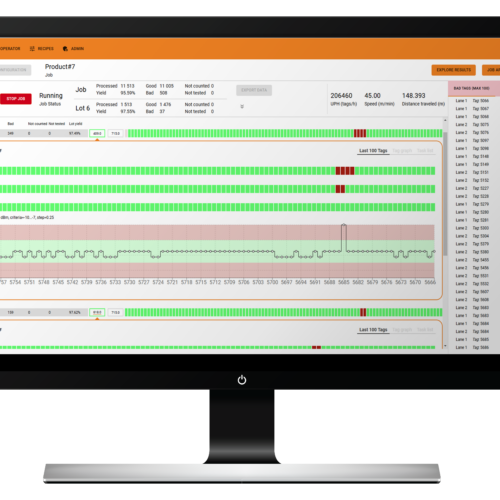I recently visited an NFC forum meeting where I listened to industry presentations and discussed with many NFC industry experts. User experience, user expectation, and physical level interoperability of various NFC devices came up frequently. This prompted me to finish this article, a draft version was written already a while ago. I tested a few smartphones for NFC tapping user-friendliness and dug a bit deeper into the factors affecting the user experience.
Three NFC Application Types
When I think of NFC, I think of three very different application types and different experiences with them.
- Smart card: Think of a hotel keycard or a metro ticket. In my experience, NFC works smoothly and reliably in these applications. I have frequently had issues with magnetic stripe key cards, but NFC has worked perfectly. In these applications, a consumer carries the tag and a dedicated reader is used.
- Device-to-device: There are also emerging examples with excellent feedback of applications where 2 devices share information. For example, a phone placed to a center console of a car controls the settings of the car’s infotainment system.
- Simply tap: Third big promise of NFC is in applications where consumer carries a smartphone and interacts with NFC tagged items to receive more information. That is when the user experience changes – and not in a good direction.
The third application type – Simply tap – is the focus of this article.
Simply Tap Experience – Not So Simple
Promise: NFC works like waving a magic wand – simply tap.
It is a familiar situation: There is a web-link encoded to an NFC tag and the smartphone’s NFC is turned on. Enthusiastic user calmly extends the elbow and taps the tag with the top end of the phone – a move similar to a sorcerer waving a magic wand – but this time magic doesn’t happen.
Reality: Despite relentless tag rubbing with a smartphone – nothing happens.
Next try – slowly position the back cover of the phone on top of the tag – still nothing. Move the phone sideways on top of the tag; up to down; down to up; corner to corner – waving the magic wand did not work, maybe the NFC genie can be rubbed out from the tag. No. Check the settings. Try again. Ask a friend: “did you read it?” It should work – but it didn’t – no error message – nothing. A too common NFC user experience turns from a hopeful magic wand tapping into rubbing the NFC genie’s lamp into disappointment. What really happens? And what could be done for improving the user experience?
Digging Deeper: usually, NFC works, but details of the reading experience just don’t match the user’s expectations. In order to learn more, I looked more into what happens with smartphones and NFC. Here is what I found out.
Smartphone Reading Interval
Even if NFC is enabled, a phone is not reading NFC continuously. Instead, it checks occasionally if there is an NFC tag nearby waiting to be read. How often it is checked: As far as I know, there are no rules – most likely the interval depends on a lot of things: manufacturer’s preferences, operating system, power settings, other background applications taking up processor time, and many more. I tested two phones with Voyantic Protocol Analyzer. I found out that there is a big difference in how often phones try to read NFC tags.
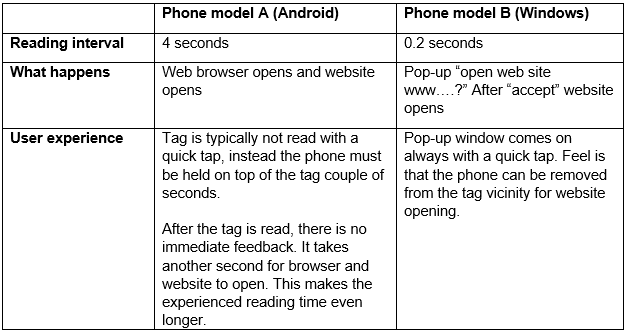
Smartphone Reading Area
Different smartphones have different NFC reading areas. Reasons are not visible, but it is easy to come up with some ideas:
- Different antenna positioning
- Different antenna size and quality
- Effect of nearby components
- Different power levels
All in all, pointing a phone to an NFC tag is done differently from model to model.
Using phones’ default settings, I tested two phones.
- With phone model A:
the ideal position was pointing upper part of the phone in 30-degree angle towards the tag - With phone model B:
the ideal position was slightly below the top part of the phone
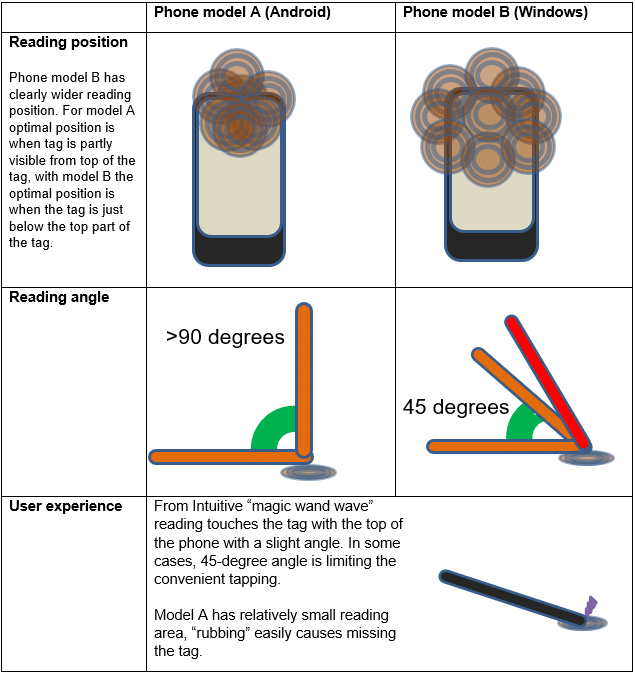
Some phone models inform the user about the antenna position on the NFC setting screen, or in the startup screen. But some leave the antenna position hidden, only to be discovered by the user by relentless rubbing and experimenting.
NFC Tag Placement
In the first tests, the NFC tag was completely visible for the user, and it was possible to touch the tag. This is not always the case. In the second test I used Voyantic Reference Material Set to simulate “tap the window” use case. The inlay was behind a business card, which was behind a sheet of glass. The user experience changed completely – and not in a good direction.
A small change in tag placement can have a huge effect
Few millimeters between the phone and the inlay – slight detuning from the glass and the fact that exact inlay position was not known made things difficult. Some tags conveniently readable on air were not readable on “tap the window” application, and with most tags, exact phone positioning was needed.
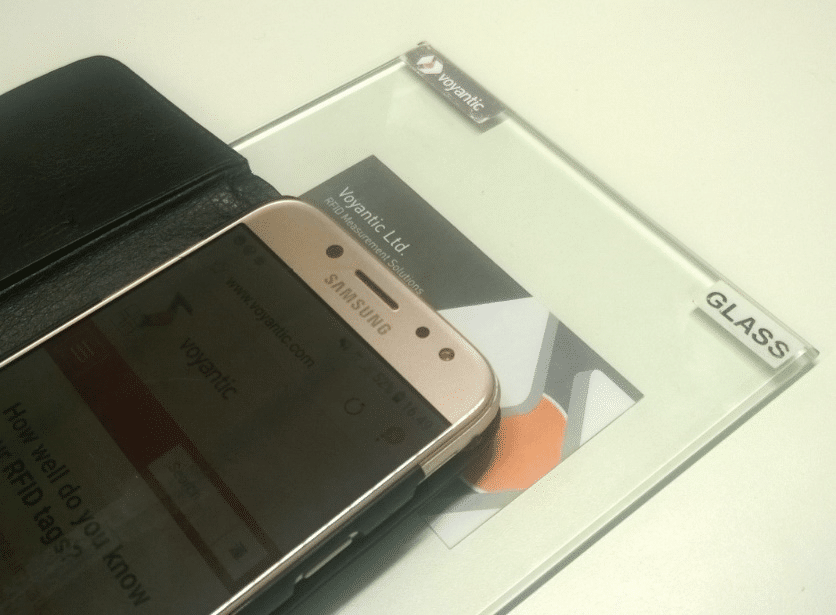
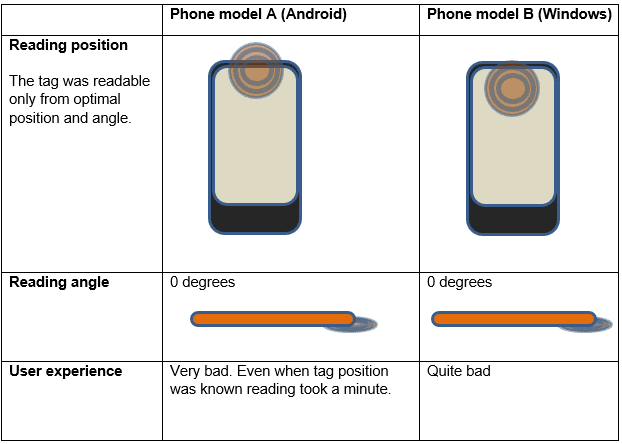
NFC Tag Sensitivity and Tuning
The above tests were made using an NFC inlay with 35 mm diameter round antenna – something that could be conveniently used in a price tag in a retail store. But tags are not equal. The inlay I used required 225 mA/m magnetic field strength for activation. When I tested two other “price tag size” NFC inlays with Voyantic Tagformance Pro the required activation energies were 750 mA/m and 1500 mA/m. Sensitivity and quality of the tag have an effect on the user experience.

When activation power increases, the practical effect is that a range of positions on which a tag can be read decreases. With both of the tested phones even weaker tags worked well when the reading position was optimal and touching the tag was possible. But slightly “mis-tapping” the tag left it unread and testing the “tap the window” use-case with phone model A was unsuccessful.
Too commonly NFC tag performance and quality are not really tested and suitability to an application is not properly evaluated. Often only antenna is tested with passive testing made with network analyzer – result tells about the antenna tuning, but that is not the full view to the NFC tag. When the chip is attached to the antenna, and when the tag is attached to an item, the tuning changes. And passive testing does not really tell anything about the required activation energy, which is the key. Only active testing tells the entire story. Below graph shows one NFC tag individual tested in 4 scenarios. Tag attached to a glass, tag on air, and antenna only.
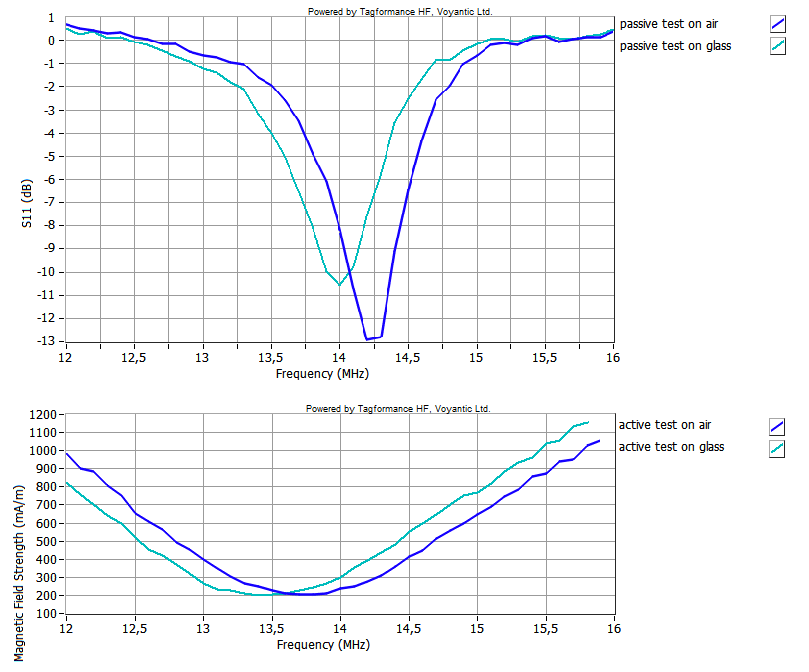
Smartphone Functionality
The test was made with two phone models, one equipped with an Android operating system and another with Windows. Both of these try reading NFC tag periodically when the NFC is turned on, without any additional applications. The full list of NFC-enabled phones is available here.
iPhone and IOS were not tested since iPhone only allows reading NFC tag with a separate application – without it no amount magic wand-waving or rubbing the NFC genie works. An upcoming iOS 13 is supposed to change this.
How Could NFC Systems Be Improved?
What can the user do?
There is not much a user can do, the only reasonable thing is to “know ones phone”: How long it takes to read a tag and what is the best reading position. The best way to find these out is to take a working tag and try. No rubbing – just touch the tag with phones top few seconds using different positions and angles. In reality, the responsibility to improve user experience lies almost entirely on technology providers.
What can system integrators do?
System integrators control several items of the system: Which tag is used, how the tag is placed, how the tag is presented and so on.
- User expectations should be steered to match the actual technology performance. Maybe replacing “tap me” with another phrase such as “tap to download” would steer the user to a longer action than a quick tap.
- When personalizing the tags the “tap me” text should indicate accurately the NFC inlay position. Incorrect or inaccurate positioning decreases the usability and results in bad user experience.
- Selecting the correct tag for an application is the cornerstone of a well-functioning NFC system. Applications and items vary – Sometimes it is possible to touch the tag with below 1 mm distance – sometimes the applications may require few millimeters reading distance. Tag tuning may also be affected by different materials on which the tag is attached. If a wrong tag is used, the system works poorly or not at all.
What can smartphone manufacturers do?
Smartphone manufacturers control the main interface between the NFC system and the user. If the interface works reliably and the use matched expectations, the system is likely to work well.
- NFC reading should be enabled on smartphones without a separate application
- Reading interval should be short enough to enable the smooth user experience
- The phone’s antenna quality and positioning should allow intuitive “tap and read” in different scenarios: tag on table and tag on the wall.
- It would help system integrators and tag manufacturers to know the phone profiles – how strong the magnetic field the phone’s NFC reader can generate at different distances. This data could be compared with the required activation energies in different applications.
What can NFC tag manufacturers do?
NFC tag is the second technical item in an NFC system. Well performing good quality NFC tags are obviously the tag manufacturers’ responsibility.
- Tag manufacturers should ensure that tag sensitivity is sufficient and quality matches the application and expected user experience. Materials between phone and tag should be taken into account.
- When printing the tag the “tap me” or other guiding text should be correctly placed and guide user expectations to the right direction.
What should NFC forum do?
NFC Forum is known for creating and maintaining the NFC standards and advocating NFC use among other industries and to consumers. In my opinion, this is also a source for some of the user experience issues.
- In addition (or even instead) of standardizing the NFC tag performance with technical terms such as defining activation magnetic field, NFC Forum could standardize (or at least recommend) user experience criteria. A tag may have one activation energy but the user experience changes, if the tag is placed on cardboard, versus behind a window. User experience should be similar in both cases. Complexity increases further if the same performance criteria is forced to device to device and smart card applications. In my opinion, the user experience requirements should be different for the three application types
- NFC forum should recommend system integrators and manufacturers to indicate clearly where the tag is placed, and where the phone´s antenna is. Discussion on this topic are on-going among NFC Forum members, and I have seen excellent practical ideas.
I am eagerly looking forward to the bright future of simply tap NFC.
Do you have any thoughts or questions about the NFC tapping? Contact us – I would be happy to discuss this in more detail!
All blog posts

